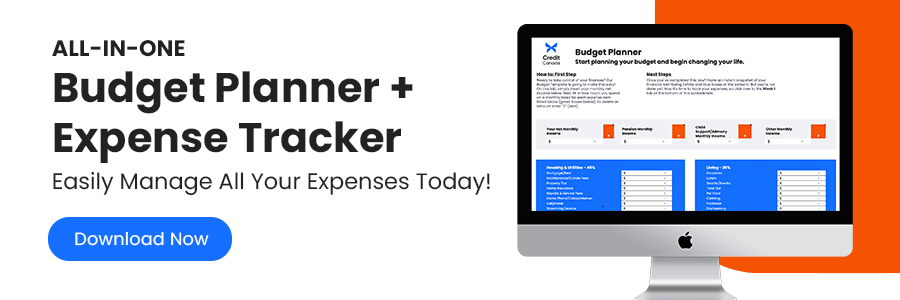
A new year means a fresh start, and the best place to begin is with your money! And you can do this by simply adopting a better understanding of budgeting and money management. The idea of budgeting can seem overwhelming, but don’t go burying your head in the sand! With the proper tools and a bit of coaching, successful money management can be achieved to make 2020 a stellar year.
Start the new decade off right by setting goals
Before you can start developing your plan, you need to determine your ultimate goals. Why are you doing all of this? We all come from different backgrounds with households of different sizes and income levels. Everyone has their own targets they are hoping to achieve. The best way to tackle this is to sit down, list these goals, and then prioritize them. And if you're a couple, it's important that you do this together. Always write down your goals because you will be more likely to stick to them. Goals can be broken down into two main categories: short-term and long-term goals. And both types of goals are equally important. A short-term goal can be something like saving up for a vacation or new couch, while a long-term goal can be something like a down payment or a new used car.
Track your variable expenses
Most of us don't track our expenses, especially not our variable expenses which typically change month-to-month, like groceries, toiletries and utility services. But if you want to make the most of your money this year, it is absolutely essential to know how much you spend. Take some time tracking your variable expenses. You can do this in a number of different ways.
For example, every time you spend money you can make a note by writing it down in a booklet, or you can make a note of it on your phone. You can also create a spreadsheet, keep envelopes to put all of your receipts in, or track your purchases online via your online bank statements and credit card transactions. Find the best way that works for you. We have a great, free online tool called a monthly "Expense Tracker” on our website, which you can download for free as an Excel file or Google spreadsheet. The idea is to track at least one full month of your expenses, but two months would be ideal. From this you will have a pretty good idea of how much you typically spend on your variable expenses on a monthly basis, and how much you will need in your budget each month to cover them.
Know your fixed expenses
Not only do we have variable expenses, but we also have "fixed" expenses which don't change every month. Examples of fixed expenses include rent, mortgage payments, property taxes, car insurance, home insurance, etc. If you have fixed expenses that you pay bi-monthly or twice a year, try to calculate them based on 12 months, so you can put a monthly amount into your monthly budget. This will ensure that you leave enough money in your budget each month to cover them when they become due.
List your fixed and variable expenses
The next step is to list all of your fixed and variable expenses together, so you can get a full picture of how much you spend in a typical month. You can do this manually by writing them all down on one page, or you can download our free monthly Budget Planner on your phone, desktop or tablet and simply plug in your fixed and variable expenses. If you're a couple, it's a good idea to go over your monthly expenses together to make sure nothing is missing. Again, compare it to your bank statements and/or online banking transactions.
Record your monthly net income
Next, you want to see how much money you have available to put towards your expenses. It would be easy to budget if we all worked on salary and were paid on a monthly basis, but that's not always the case, especially given today's gig economy and side hustle jobs where people are supplementing their incomes by becoming an Uber driver, dog walker, or renting out a room in their home on Airbnb.
If you're paid bi-weekly and your pay is always the same, simply multiply your pay by two. If your pay fluctuates, add up your total income for the last 6 months and then divide this number by 6 to get a monthly average. You can also look at your pay stub and if it shows a year to date net amount you could take that figure and divide it by the number of months. You can even use past tax returns to get a figure and divide it by 12. Ensure that you include all money coming into your account each month, including pension income, child support, child tax benefit and any other government assistance payments you receive.
Create a simple monthly budget
Now you're ready to put a budget together! If you're old school and like writing things down, you can write down all of your income items on one page, and both your fixed and variable expenses on another. Add up all your monthly income items together. Next, add up all your fixed and variable expenses together. Then subtract your monthly expenses from your monthly net income and see where you stand.
Pro tip: If you downloaded our free monthly Budget Planner, you would input your total monthly net income in the top, right-hand corner. Then the planner will automatically tell you how much money you have left over every month after taking care of all your fixed and variable expenses.
Cut expenses to create more room in your budget
Are you in a surplus or a deficit? If you have a surplus, great! But if you have a deficit, don’t despair. Take some time to go through each expense item in your budget, one at a time, and ask yourself how you might be able to reduce it. (Our free Budget Calculator can help you see how much small cuts in our everyday spending can add up after a month, a year and 5 years.) It may just be a matter of cutting back on drive-thru coffees on the way to work, or cutting back on gas by taking the bus once in a while or joining a carpool. Even fixed expenses can be lowered sometimes. Call your cable company and learn a bit more about what you're paying for and see if there are channels you can remove from your package. You can even consider changing providers if you can get a better deal. Car insurance, house insurance — call them all! You'll be surprised by how much you can trim off.
Pay off unsecured debt
Hopefully you'll have a surplus, so you can start putting some money towards paying off your debt. If you don't have a surplus, or you think it's not enough to make a dent in your debt, you may need to go through your budget again to make more cuts to your expenses. You can also consider different ways to increase your income.
Regardless of whether or not you have a surplus or deficit, the next step is to go through all of your individual unsecured debts (credit cards, payday loans, unsecured lines of credit, etc.) and figure out the best debt repayment strategy for you to go about paying them off, one by one. If you don't know where to start, you can use our free Debt Calculator. Simply plug in the different debts you have and their respective interest rates. Then plug in how much money you have in total every month (i.e., your monthly surplus) to pay them off. The calculator will then give you all the different ways you can pay off your debts, and how much money you can save in interest. It will also tell you how long it will take you to be debt-free using the different debt repayment strategies.
If you have debt but you're feeling very financially stretched and you're not sure how you can pay it all off, consider booking a free appointment with a certified Credit Counsellor. They can look at all the different options you have available to pay the debt off.
Put money towards your savings every month
This is an important step for good financial health. Whenever we hear the word "savings" we tend to think this only refers to our retirement savings, but that's not the case. Yes, a good retirement plan is important but we need to save for other things in life too, like a vacation, a new appliance and an emergency fund.
Having an emergency fund is crucial for a good budget to survive. All it can take is a bad muffler or an unexpected dental bill to completely throw a wrench in your budget. If you haven’t been putting a specific amount of money aside each month to cover these inevitable yet "unexpected" expenses, you'll find yourself in trouble and most likely relying on credit to get you through it. You should avoid using credit cards for emergencies — it's the worst emergency plan you can have due to the interest rates they charge. Plus, if you can’t afford to pay for an unexpected cost when it comes up, you likely won’t be able to pay for it next month when your credit card bill arrives either.
Make your budget work for you
So now you have your budget, you have a debt repayment plan, and you have a plan to set money aside for savings. Believe it or not, you’re not done. Now is when the real work begins: Making your budget work for you.
Once you've stuck with your budget for a few months, you'll start to see the rewards, such as your debts going down and your savings going up. You'll also find it gets easier and more satisfying the more your stick to your budget. Make sure you continue to track your variable expenses and include everything in your budget; you are only cheating yourself if you don't. You can also consider creating a monthly checklist for your fixed expenses, and check them off every time you make a bill payment or the money comes out of your bank account. This will not only help you stay on top of your monthly bills, which helps build a healthy credit score, but you'll also be able to check that the fixed expense amounts don’t change from what you originally budgeted.
Contact Credit Canada for free debt help
So here’s to stress-free budgeting and money management! Lets all get our heads out of the sand and face our own numbers, because once you get yourself organized, life can be a lot less stressful. Through smart budgeting and money management, you’ll feel more in control of making your money work for you. Take advantage of the free tools I mentioned, and book a free counselling session with one of our amazing certified Credit Counsellors at Credit Canada. All of our counselling is free, confidential and non-judgmental. Just call 1.800.267.2272 to book!
Frequently Asked Questions
Have a question? We are here to help.
What is a Debt Consolidation Program?
A Debt Consolidation Program (DCP) is an arrangement made between your creditors and a non-profit credit counselling agency. Working with a reputable, non-profit credit counselling agency means a certified Credit Counsellor will negotiate with your creditors on your behalf to drop the interest on your unsecured debts, while also rounding up all your unsecured debts into a single, lower monthly payment. In Canada’s provinces, such as Ontario, these debt payment programs lead to faster debt relief!
Can I enter a Debt Consolidation Program with bad credit?
Yes, you can sign up for a DCP even if you have bad credit. Your credit score will not impact your ability to get debt help through a DCP. Bad credit can, however, impact your ability to get a debt consolidation loan.
Do I have to give up my credit cards in a Debt Consolidation Program?
Will Debt Consolidation hurt my credit score?
Most people entering a DCP already have a low credit score. While a DCP could lower your credit score at first, in the long run, if you keep up with the program and make your monthly payments on time as agreed, your credit score will eventually improve.
Can you get out of a Debt Consolidation Program?
Anyone who signs up for a DCP must sign an agreement; however, it's completely voluntary and any time a client wants to leave the Program they can. Once a client has left the Program, they will have to deal with their creditors and collectors directly, and if their Counsellor negotiated interest relief and lower monthly payments, in most cases, these would no longer be an option for the client.







